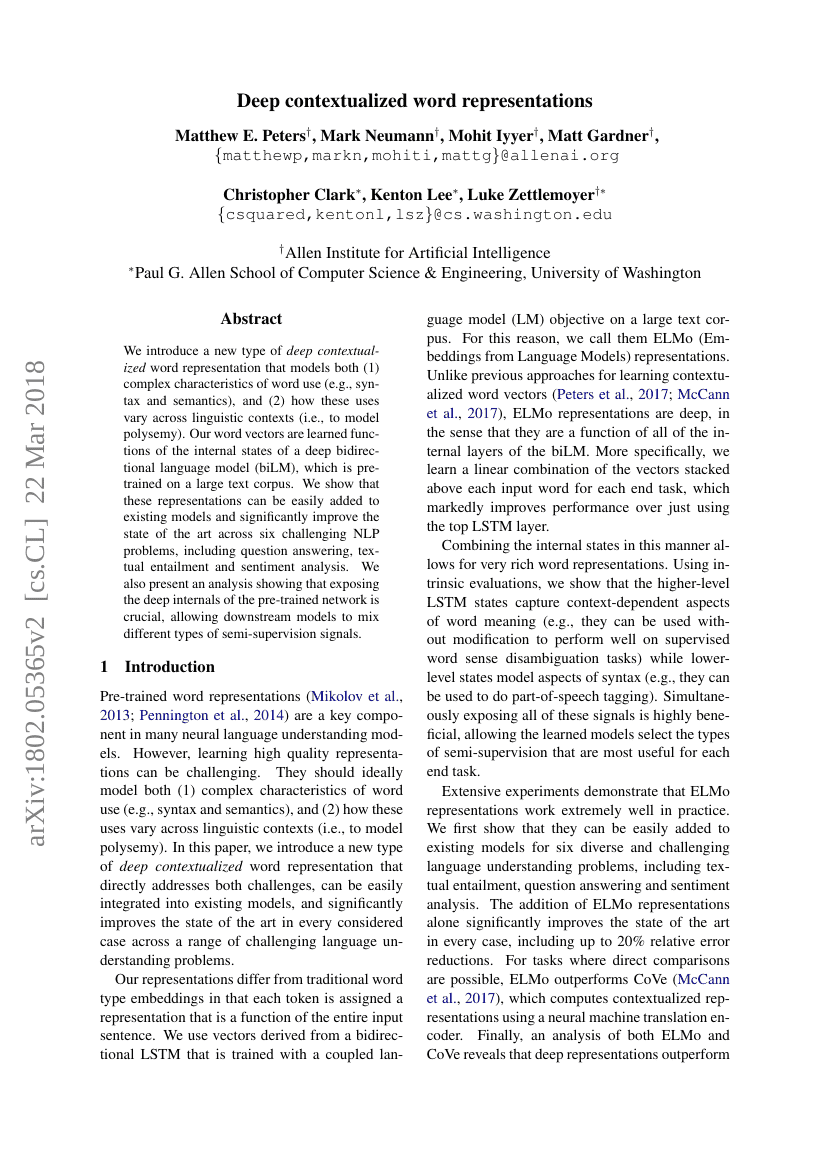
摘要
我们介绍了一种新型的深度上下文化词表示方法,该方法不仅建模了词使用的复杂特征(如句法和语义),还建模了这些用法在不同语言环境中的变化(即多义性建模)。我们的词向量是从一个经过大规模文本语料库预训练的深层双向语言模型(biLM)的内部状态中学习得到的函数。我们展示了这些表示可以轻松添加到现有模型中,并显著提升了六个具有挑战性的自然语言处理问题的最新水平,包括问答、文本蕴含和情感分析。此外,我们还进行了分析,表明暴露预训练网络的深层内部结构至关重要,这使得下游模型能够混合不同类型的部分监督信号。
代码仓库
bplank/teaching-dl4nlp
GitHub 中提及
menajosep/AleatoricSent
tf
GitHub 中提及
TEAMLAB-Lecture/deep_nlp_101
tf
GitHub 中提及
zenanz/ChemPatentEmbeddings
tf
GitHub 中提及
yangrui123/Hidden
tf
GitHub 中提及
UKPLab/elmo-bilstm-cnn-crf
tf
GitHub 中提及
JHart96/keras_elmo_embedding_layer
tf
GitHub 中提及
flairNLP/flair
pytorch
GitHub 中提及
LamLauChiu/Tensorflow_Learning
tf
GitHub 中提及
Mind23-2/MindCode-98
mindspore
GitHub 中提及
shelleyHLX/bilm_EMLo
tf
GitHub 中提及
mingdachen/bilm-tf
tf
GitHub 中提及
horizonheart/ELMO
tf
GitHub 中提及
seunghwan1228/ELMO
tf
GitHub 中提及
sarveshsparab/DeepElmoEmbedNer
tf
GitHub 中提及
richinkabra/CoVe-BCN
pytorch
GitHub 中提及
yuanxiaosc/ELMo
tf
GitHub 中提及
kaist-dmlab/BioNER
pytorch
GitHub 中提及
Hironsan/anago
GitHub 中提及
ankurbanga/Language-Models
pytorch
GitHub 中提及
PrashantRanjan09/Elmo-Tutorial
tf
GitHub 中提及
dmlc/gluon-nlp
mxnet
bestend/tf2-bi-lstm-crf-nni
tf
GitHub 中提及
kunde122/bilm-tf
tf
GitHub 中提及
kafura-kafiri/tf2-elmo
tf
GitHub 中提及
AshwinDeshpande96/Hierarchical-Softmax
tf
GitHub 中提及
young-zonglin/bilm-tf-extended
tf
GitHub 中提及
helboukkouri/character-bert
pytorch
GitHub 中提及
HIT-SCIR/ELMoForManyLangs
pytorch
GitHub 中提及
nlp-research/bilm-tf
tf
GitHub 中提及
yuanjing-zhu/elmo
pytorch
GitHub 中提及
yangzonglin1994/bilm-tf-extended
tf
GitHub 中提及
RundongChou/elmo-chinese-oversimplified
tf
GitHub 中提及
griff4692/LMC
pytorch
GitHub 中提及
iliaschalkidis/ELMo-keras
tf
GitHub 中提及
2023-MindSpore-1/ms-code-190
mindspore
GitHub 中提及
IMPLabUniPr/UniParma-at-semeval-2021-task-5
pytorch
GitHub 中提及
YC-wind/embedding_study
tf
GitHub 中提及
cheng18/bilm-tf
tf
GitHub 中提及
weixsong/bilm-tf
tf
GitHub 中提及
allenai/bilm-tf
tf
GitHub 中提及
shaneding/bilm-tf-experimentation
tf
GitHub 中提及
kinimod23/NMT_Project
GitHub 中提及
基准测试
| 基准 | 方法 | 指标 |
|---|---|---|
| citation-intent-classification-on-acl-arc | BiLSTM-Attention + ELMo | Macro-F1: 54.6 |
| conversational-response-selection-on-polyai | ELMO | 1-of-100 Accuracy: 19.3% |
| coreference-resolution-on-ontonotes | e2e-coref + ELMo | F1: 70.4 |
| named-entity-recognition-ner-on-conll-2003 | BiLSTM-CRF+ELMo | F1: 92.22 |
| named-entity-recognition-on-conll | BiLSTM-CRF+ELMo | F1: 93.42 |
| natural-language-inference-on-snli | ESIM + ELMo Ensemble | % Test Accuracy: 89.3 % Train Accuracy: 92.1 Parameters: 40m |
| natural-language-inference-on-snli | ESIM + ELMo | % Test Accuracy: 88.7 % Train Accuracy: 91.6 Parameters: 8.0m |
| question-answering-on-squad11 | BiDAF + Self Attention + ELMo (ensemble) | EM: 81.003 F1: 87.432 |
| question-answering-on-squad11 | BiDAF + Self Attention + ELMo (single model) | EM: 78.58 F1: 85.833 |
| question-answering-on-squad11-dev | BiDAF + Self Attention + ELMo | F1: 85.6 |
| question-answering-on-squad20 | BiDAF + Self Attention + ELMo (single model) | EM: 63.372 F1: 66.251 |
| semantic-role-labeling-on-ontonotes | He et al., 2017 + ELMo | F1: 84.6 |
| sentiment-analysis-on-sst-5-fine-grained | BCN+ELMo | Accuracy: 54.7 |
| task-1-grouping-on-ocw | ELMo (LARGE) | # Correct Groups: 55 ± 4 # Solved Walls: 0 ± 0 Adjusted Mutual Information (AMI): 14.5 ± .4 Adjusted Rand Index (ARI): 11.8 ± .4 Fowlkes Mallows Score (FMS): 29.5 ± .3 Wasserstein Distance (WD): 86.3 ± .6 |
| word-sense-disambiguation-on-supervised | ELMo | SemEval 2007: 62.2 SemEval 2013: 66.2 SemEval 2015: 71.3 Senseval 2: 71.6 Senseval 3: 69.6 |